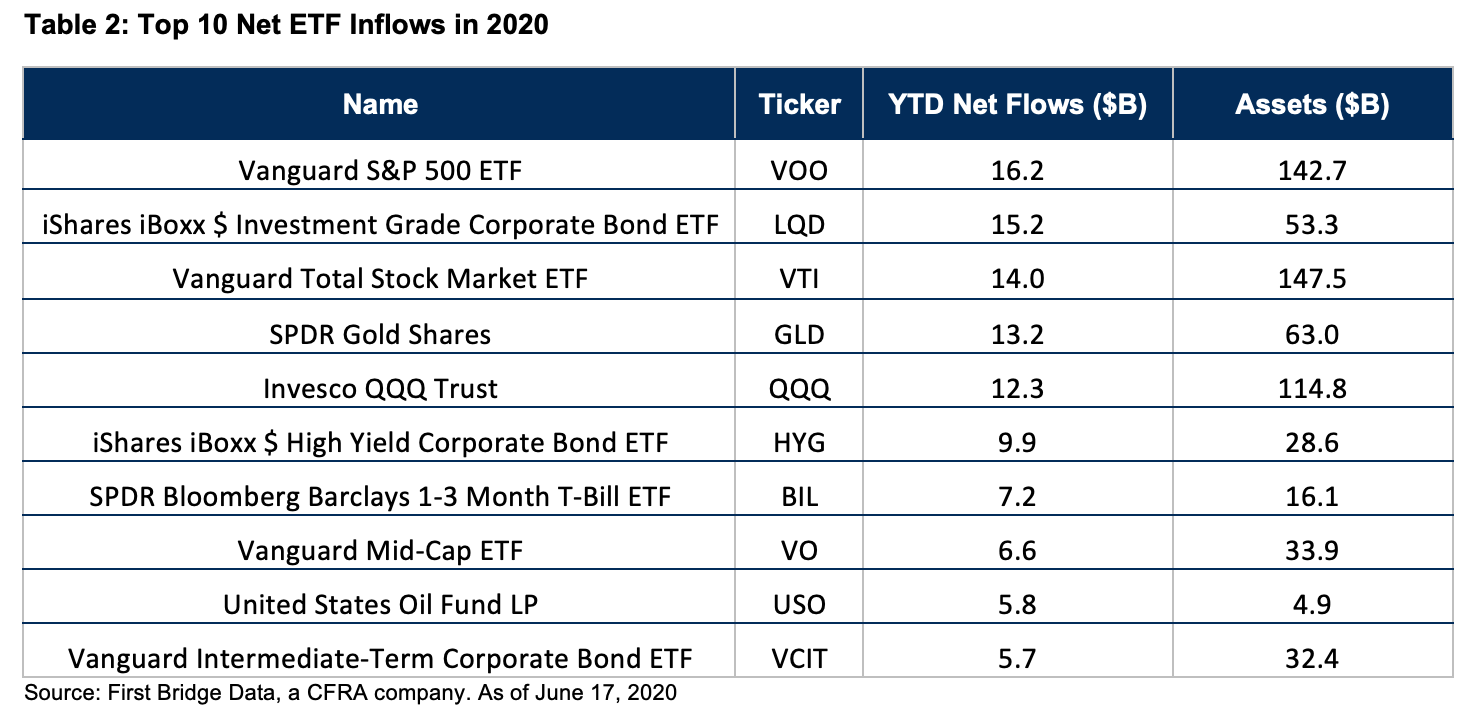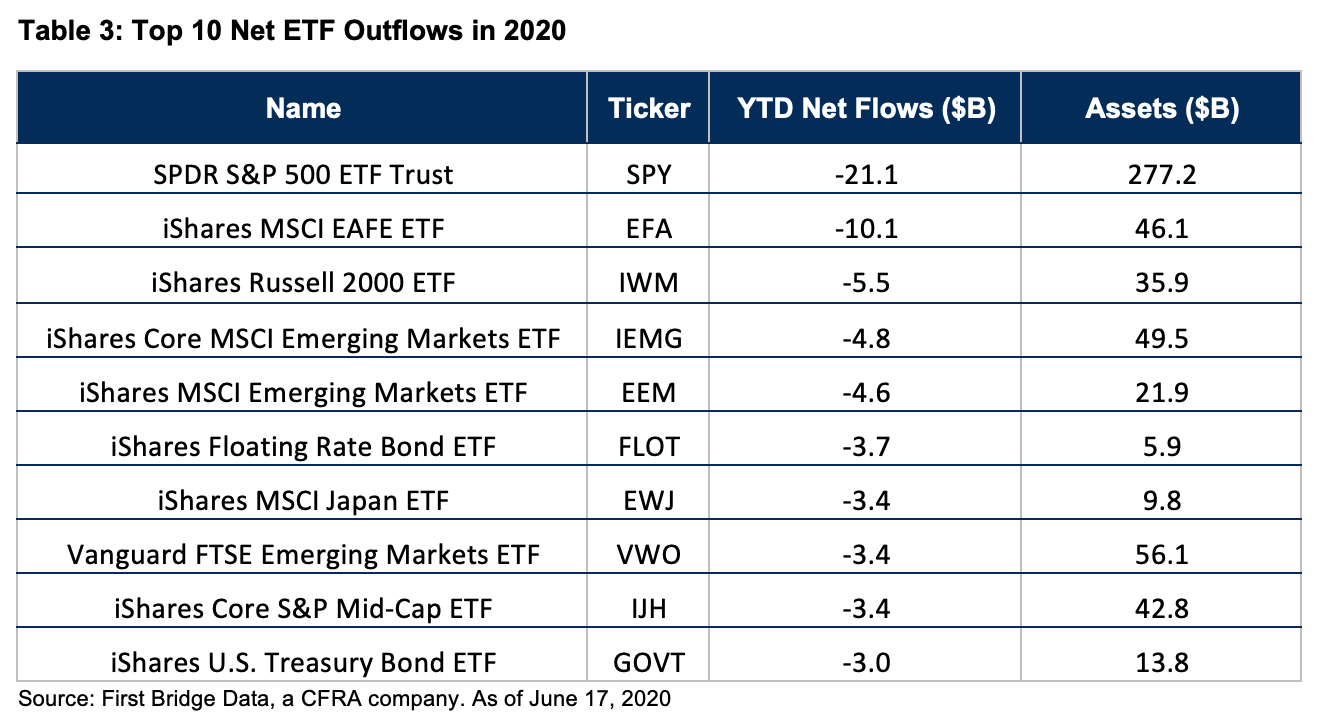ETFs passed the test in 2020.
Year to date through June 17, the ETF industry gathered $187 billion of new money, according to First Bridge Data—on pace to exceed the $328 billion of net inflows from 2019, despite the emergence of an equity bear market and a COVID-19-driven recession. While 2019 had the second-strongest ETF inflows ever, behind only 2017’s cash haul, skepticism remained prevalent that equity ETF investors would bail if the market volatility spiked while fixed income investors would face liquidity challenges from these relatively young products. The first six months of 2020 allowed ETFs to take and pass these tests.
The $74 billion equity ETFs gathered to start 2020 was strong, given the declines in most U.S. and international indexes. Rather than heading to the sidelines, many investors rebalanced into low-cost U.S. asset allocation products, such as Vanguard Total Stock Market Index (VTI) Others favored growth-oriented funds, such as Invesco QQQ Trust (QQQ). QQQ is highly exposed to information technology, internet retail and biotechnology companies positioned to benefit from the COVID-19 environment.
Meanwhile, fixed income ETF investors did not incur significant liquidity challenges when selling, and indeed many of these funds have been in high demand as a replacement for individual bonds. Fixed income ETFs collectively gathered $81 billion of new money as of mid-June and were on pace to exceed 2019’s record-setting $157 billion.
Fixed income and commodity ETFs punching above their weight
Commodity ETFs collected $32 billion in net inflows so far this year. For the ETF category as a whole, the asset base continues to increase. After dipping below $4 trillion in overall assets at the end of the first quarter, the industry had $4.4 trillion as of mid-June—due to strong inflows and a partial recovery of the underlying securities. Relative to peers, the fixed income category captured 43% of the industry’s new money in 2020, more than double its 21% overall share. In contrast, equity ETFs garnered 40% of the net inflows, almost half their 75% share of assets.
Though commodity ETFs make up just 3% of the assets, they pulled in a fivefold increase with a 17% share of net inflows thus far in 2020. As we will discuss, energy and gold ETFs were popular, though for different reasons.

Credit-sensitive fixed income ETFs were in vogue
Demand for fixed income ETFs was aided directly and indirectly by the Federal Reserve’s purchases of $5.5 billion worth of ETFs as of June 9 to support credit market liquidity. We think investor confidence toward fixed income ETFs also improved, as the category’s products traded relatively efficiently during the market volatility. iShares iBoxx $ Investment Grade Corporate Bond ETF (LQD), iShares iBoxx $ High Yield Corporate Bond ETF (HYG) and Vanguard Intermediate-Term Corporate Bond ETF (VCIT) pulled in $15 billion, $9.9 billion and $5.7 billion, respectively this year—landing on the top 10 list of asset gatherers. LQD and VCIT invest in bonds rated BBB or higher, while HYG incurs more elevated credit risk with lower-rated bonds.
Risk-off and risk-on investors embraced commodity ETFs
SPDR Gold Shares’ (GLD) $13 billion of net inflows ranked fourth overall, as investors sought exposure to the yellow metal as a hedge against economic uncertainty and fiscal deficits. Investors were rewarded as GLD significantly outperformed equity ETFs this year with double-digit returns. In contrast, demand for United States Oil Fund (USO) was driven as investors sought to bottom fish despite falling energy demand. USO is the rare example where the $5.8 billion of net inflows in 2020 exceeds the $4.9 billion in fund assets, as the fund was down more than 70% this year.

The largest ETF inflows and outflows came from products tracking the same index
Vanguard S&P 500 ETF (VOO) pulled in more than $16 billion in the nearly six months of the year to push its asset base above $140 billion. Some of the new money likely stemmed from outflows from SPDR S&P 500 ETF (SPY). SPY had $21 billion of redemptions, as investors sought a cheaper alternative to SPY’s 0.09% expense ratio. Yet, we think these products appeal to different investors. VOO’s 0.03% expense ratio generates more interest from cost-conscious retail investors for asset allocation purposes, while the high liquidity that stems from SPY’s daily volume of approximately 100 million shares appeals to institutional investors.

Broadly diversified emerging markets were out of favor regardless of fees
The now $22 billion iShares MSCI Emerging Markets ETF (EEM) has been bleeding assets in recent years, as retail and institutional investors have preferred cheaper alternatives, including the $56 billion Vanguard FTSE Emerging Markets ETF (VWO) and $50 billion iShares Core MSCI Emerging Markets ETF (IEMG). However, in 2020, all three of these ETFs experienced high outflows as investors limited exposure to China, Taiwan, India and other typically high-growth but high-risk markets. IEMG’s $4.8 billion of redemptions modestly exceeded EEM’s $4.6 billion, even though IEMG’s 0.14% expense ratio is less than one-fourth the price of EEM. With $3.4 billion of net outflows, VWO was the only other ETF besides SPY from the top 10 outflows list not managed by iShares.
iShares Russell 2000 ETF (IWM), iShares Floating Rate Bond ETF (FLOT) and iShares MSCI Japan ETF (EWJ) were among the others from iShares to have more than $3 billion of net outflows.
Conclusion
ETF inflows so far this year demonstrate the ongoing popular of ETFs as an investment instrument, as well as a broadening of interest beyond equities and into fixed income and commodity ETFs. This is a trend CFRA expects to continue.
Todd Rosenbluth is the director of ETF and mutual fund research at CFRA. Learn more about CFRA's ETF research here.





